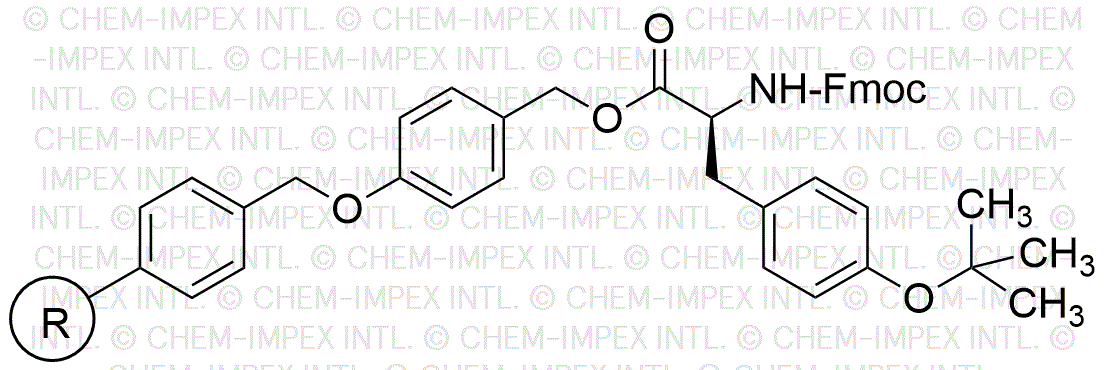Fmoc-O-tert-butyl-L-tyrosine 4-alkoxybenzyl alcohol is widely utilized in research focused on:
- Peptide Synthesis: This compound serves as a key building block in the synthesis of peptides, particularly in solid-phase peptide synthesis, allowing for the creation of complex and functional peptide sequences.
- Drug Development: It is employed in the development of pharmaceutical compounds, especially those targeting specific receptors, enhancing the efficacy and selectivity of drug candidates.
- Bioconjugation: The chemical is used in bioconjugation techniques, facilitating the attachment of biomolecules to drugs or imaging agents, which is crucial for targeted therapy and diagnostics.
- Research in Neuroscience: Its derivatives are explored in neuroscience research for studying neurotransmitter pathways and developing neuroprotective agents.
- Cosmetic Formulations: The compound finds applications in cosmetic chemistry, particularly in formulations aimed at skin rejuvenation and anti-aging, due to its potential beneficial effects on skin cells.
Informations générales
Propriétés
Sécurité et réglementation
Applications
Fmoc-O-tert-butyl-L-tyrosine 4-alkoxybenzyl alcohol is widely utilized in research focused on:
- Peptide Synthesis: This compound serves as a key building block in the synthesis of peptides, particularly in solid-phase peptide synthesis, allowing for the creation of complex and functional peptide sequences.
- Drug Development: It is employed in the development of pharmaceutical compounds, especially those targeting specific receptors, enhancing the efficacy and selectivity of drug candidates.
- Bioconjugation: The chemical is used in bioconjugation techniques, facilitating the attachment of biomolecules to drugs or imaging agents, which is crucial for targeted therapy and diagnostics.
- Research in Neuroscience: Its derivatives are explored in neuroscience research for studying neurotransmitter pathways and developing neuroprotective agents.
- Cosmetic Formulations: The compound finds applications in cosmetic chemistry, particularly in formulations aimed at skin rejuvenation and anti-aging, due to its potential beneficial effects on skin cells.
Documents
Fiches de données de sécurité (FDS)
La FDS fournit des informations de sécurité complètes sur la manipulation, le stockage et l’élimination du produit.
Spécifications du produit (PS)
Le PS fournit une description complète des propriétés du produit, notamment sa composition chimique, son état physique, sa pureté et les exigences de stockage. Il détaille également les plages de qualité acceptables et les applications prévues du produit.
Certificats d'analyse (COA)
Recherchez des certificats d'analyse (COA) en saisissant le numéro de lot du produit. Les numéros de lot et de lot se trouvent sur l'étiquette d'un produit, après les mots « Lot » ou « Lot de fabrication ».
Numéro de catalogue
Numéro de lot/série
Certificats d'origine (COO)
Ce certificat d'exploitation confirme le pays dans lequel le produit a été fabriqué, et détaille également les matériaux et composants utilisés et s'il est issu de sources naturelles, synthétiques ou autres sources spécifiques. Ce certificat peut être requis pour les douanes, le commerce et la conformité réglementaire.
Numéro de catalogue
Numéro de lot/série
Fiches de données de sécurité (FDS)
La FDS fournit des informations de sécurité complètes sur la manipulation, le stockage et l’élimination du produit.
DownloadSpécifications du produit (PS)
Le PS fournit une description complète des propriétés du produit, notamment sa composition chimique, son état physique, sa pureté et les exigences de stockage. Il détaille également les plages de qualité acceptables et les applications prévues du produit.
DownloadCertificats d'analyse (COA)
Recherchez des certificats d'analyse (COA) en saisissant le numéro de lot du produit. Les numéros de lot et de lot se trouvent sur l'étiquette d'un produit, après les mots « Lot » ou « Lot de fabrication ».
Numéro de catalogue
Numéro de lot/série
Certificats d'origine (COO)
Ce certificat d'exploitation confirme le pays dans lequel le produit a été fabriqué, et détaille également les matériaux et composants utilisés et s'il est issu de sources naturelles, synthétiques ou autres sources spécifiques. Ce certificat peut être requis pour les douanes, le commerce et la conformité réglementaire.

